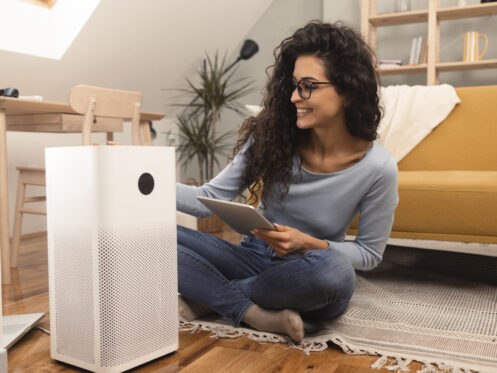Indoor air quality is a topic overlooked by many people, but it is extremely important. If the water flowing into your house was brown and smelly, you wouldn’t drink it because you’d be worried it would make you sick. You’d then call a plumber or your local water company to see what is causing the issue and what can be done to fix it.
The same should go for the air quality in your home. If your indoor air quality is low, you could wind up falling severely ill, especially if you have underlying respiratory conditions. Once you discover indoor air quality issues, you should contact a professional to take steps to lower indoor air pollution to make your home a healthier place.
One of the reasons people tend to overlook indoor air pollution is because they correlate it to outdoor air quality. If the air outside seems fresh and clean, then the air indoors should be roughly the same. However, this isn’t true. The air pollution indoors is usually worse than it is outdoors. There are several reasons behind this stark contrast in air quality.
Lack of Ventilation
The outdoors has a natural method of improving air quality in any area by utilizing plants and gusts of wind. Plants act as a filter for the air. They take in carbon dioxide and then produce fresh oxygen. Wind can take concentrated pollution and disperse it over wide areas, diluting it and keeping it moving to continuously lower the concentration.
The situation is very different indoors. It’s common for homes to not have adequate ventilation, which makes it very difficult for the pollutants to disperse and escape. The average person spends a lot of time indoors. Without strong ventilation and air filtration, you wind up constantly breathing heavily polluted air for the majority of your day.
It’s not difficult to open a few windows, but you can’t do that during winter or when it’s raining. You also don’t want to create a safety risk in your home by leaving windows open all day and night. To make matters worse, outdoor air pollution enters your home and adds to the indoor air pollution when you regularly keep windows open.
Cooking
Most cooking occurs indoors in your oven or on your stove. In many cases, cooking causes indoor air pollution to spike. Most forms of cooking release volatile organic compounds or VOCs that can cause severe health problems in high concentrations.
Cooking on a gas stove is the worst option in regards to creating indoor air pollutants. The burning natural gas releases a large amount of VOCs, carbon monoxide, and other toxins into the air as your food cooks.
Electric ovens, stoves and microwaves aren’t as harmful, but they still release particulates that add to indoor air pollution. Self-cleaning electric ovens drastically lower indoor air quality. During the self-cleaning process, the oven reaches extremely high temperatures and burns off stubborn spilled food particulates that create large amounts of VOCs.
Fireplaces
Fireplaces are cozy and beautiful, but they’re also major contributors to indoor air pollution. Burning wood creates smoke, harmful particulates, carbon monoxide, methane, and other pollutants. The chimney helps clear out some of these pollutants, but many of them stay contained in your home.
Dust
In most households, dust accumulates extremely quickly, and many people don’t remove it effectively. Dust is a collection of a wide variety of particulates that contribute to air pollution. These include skin cells, pet dander, pollen, soot, dirt, dead bugs, bacteria, hair, dried mold spores, and more.
You’re constantly kicking around dust in your home as you walk around, move things, turn on the fan and just go about your day. Methods of cleaning up the dust like using a broom or feather duster only force the particles into the air, making the air quality even worse.
Use of Chemicals
There’s a reason why a lot of chemicals have a warning on the label that tells you to only use them in a well-ventilated area or outdoors. Everyday chemical products like paint, hair spray, cleaners, bleach, pesticides, and air fresheners release many VOCs and other toxins into the air.
Some chemicals are so harmful to inhale that you could cause lasting damage to your lungs with a few deep breaths. Using these products indoors without strong airflow to help disperse and release the pollutants is extremely harmful, but it’s a very common behavior in most households.
Smoking
Cigarettes are already harmful enough to the health of people who choose to smoke, but they also contribute heavily to indoor air pollution and pose a risk to everyone else in the house. Millions of people suffer from illnesses related to inhaling secondhand smoke, including lung cancer, without ever smoking once in their lives. Even if you only smoke when no one else is in the room, the smoke hangs in the air for hours and settles onto surfaces and in fabrics, drastically increasing the amount of air pollution in your home.
Rugs and Furniture
No home is complete without some rugs and furniture, but even those items contribute to poor indoor air quality. Furniture and rugs contain formaldehyde and VOCs. In addition, they tend to collect a lot of dust, hair, animal fur, dander, pollen, dust mites, and much more that continuously disperse into the air as you walk across your carpet or sit on your couch.
Asbestos
Asbestos is a substance that was frequently used in building materials decades ago. Exposure to asbestos causes asbestosis, lung cancer and mesothelioma. The use of asbestos has drastically declined over the years since the links to harmful health effects were discovered, but it is still used in numerous products today.
Most newer homes won’t have asbestos problems, but homes built before 1980 could have severe air quality issues due to asbestos. No amount of cleaning or ventilation helps with asbestos. You need to have a professional cleaning crew that is trained in asbestos removal come out to your home and extract it all safely.
Pollution From People
Believe it or not, everyone in your house contributes to air pollution even without doing a single thing. Your body gives off pollutants through your skin and breath, and you spread bacteria through the air in your breath, mucus, and saliva. Even substances on people such as deodorant, hair spray, and perfume produce VOCs. With people spending increasing amounts of time indoors, the amount of air pollution caused by their presence increases as well.
A high-quality air filter removes most of the harmful particulates, bacteria, dust, dander, pollen, and more from your home to drastically reduce indoor air pollution. If you’d like to have a high-quality air filter installed in your residence, our experienced technicians at Sigwald Service Co. will guide you through our selection to find the best one for your needs. In addition to air filters, we also provide installation, repair and maintenance services for heaters and air conditioners. To learn more about any of the services we offer to residents in and around Rockport, Texas, contact us at Sigwald Service Co. today.






